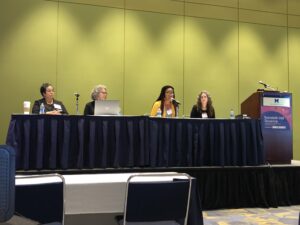Susan Perkins, PhD, director of the Biostatistics, Epidemiology, and Research Design program of the Indiana Clinical and Translational Sciences Institute (CTSI), recently organized two important Diversity, Equity and Inclusion sessions for the Association for Clinical and Translational Science (ACTS) conference in Chicago held April 20-22. Sessions attracted good attendance with approximately 100 coming to the panel discussion and 85 showing up for the presentation on approaches to replacing race categories in research.

Susan Perkins (far right) participates in panel discussion about diversity
The first session was a panel discussion, “Incorporating Justice, Equity, Diversity and Inclusion Across the Life Cycle of a Research Study,” focused on key issues that need to be addressed to develop methodological best practices for incorporating justice, equity, diversity, and inclusion into the life cycle of clinical research studies, including the stages of study design, data capture, analysis and interpretation. Panelists included Perkins, Shawnita Sealy-Jefferson, PhD, of The Ohio State University, Jareen Meinzen-Derr, PhD, of Cincinnati Children’s Hospital Medical Center, and Felicity Enders, PhD, of Mayo Clinic.
“It’s important to address diversity, equity and inclusion issues across the entire lifetime of a study because all stages of research are related to each other,” explained Perkins, who is also a professor of biostatistics and health data science at IU School of Medicine. “Everyone should have the opportunity to attain their full health potential, regardless of their social position or other socially defined circumstances. And, equitable health care leads to more efficient healthcare systems overall because a healthier population requires less medical care.”
Primary audience discussion points included the suggestion that current research should be focusing on why there are health disparities rather than if there are disparities, which is already a known indicator. For example, Perkins noted that studies should be designed with sufficient sample sizes to conduct within-group analyses (such as within-race or within-gender). Panelists also emphasized that more diversity in translational researchers is needed, including with research staff, and that researchers need to avoid using race as a surrogate for other measures, such as biology, socio-economic status, and education.
In a second session, “Replacing Race-Ethnicity: New Measures of Structural Racism and Experience of Discrimination,” Perkins moderated a conversation that included Enders and Geoff Dougherty, PhD, of Johns Hopkins University, as panelists who presented new approaches to replace standard ethnoracial categories in biomedical research with measures that are better aligned with lifetime or home and neighborhood experience of discrimination and stress. At the neighborhood or county level, researchers typically measure structural racism with a single indicator.
Enders cautioned that researchers should avoid using race as a proxy for other measures such as racism, discrimination, generational wealth, and social determinants of health. She noted that the few existing measures of discrimination and stress are temporal and sometimes restricted to specific race/ethnicities. They do not address the concept of weathering, she said, which is health deterioration as a physical consequence of cumulative socioeconomic disadvantage.
Enders presented the concept of measuring individual-level lifetime discrimination and stress and presented some of her preliminary research that measures each concept by a mild, moderate or severe score across multiple spans of an individual’s lifetime.
Dougherty presented his multi-indicator scale for structural racism (including indicators reflecting education, housing, employment, criminal justice, and health care) at the county level using publicly available data. Using a multi-indicator scale broadens the domains in which structural racism is assessed and is also used to understand disparities in health outcomes.
